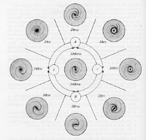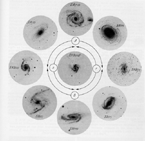


II. MORPHOLOGY
a) Qualitative morphology.
4. Description of typical
examples. The following eleven plates
illustrate the revised classification system and will serve to support
the description of the main morphological characteristics used as
classification criteria. Since the revised three-dimensional
classification recognizes at least 16 stages along the sequence from E
to Im and 9 or more pure or mixed types at each stage across it (at
least in the spiral sequences), a fully illustrated description,
allowing also for tilt and orientation effects, would require several
hundred examples. However, the main criteria used to define the
position of any normal galaxy along and across the classification
volume can be illustrated with only a fraction of the total number of
possible cases.
Plates I
and II describe the main
criteria used to distinguish between families and varieties in a
central cross-section near the stage Sb.
Plates III and IV illustrate the
ellipticals and principal stages of the lenticular sequences.
Plates V and VI illustrate the four main
stages along each of the
four principal sequences of ordinary and barred spirals.
Plate VII shows the (magellanic)
irregular later stages of the spiral sequences.
Plates VIII and IX illustrate the
appearance of edgewise system of the lenticular, spiral and irregular
classes.
Plate X illustrates the effects of
tilt and orientation on the appearance of SB (s) a or SB (r)
a spirals.
Plate XI shows some peculiar
lenticulars and (non-magellanic) irregulars of the M 82 type.
In order to minimize as far as possible
the complications arising from differences in scale and resolution,
several sources of illustrations were used as follows:
1. Mt. Palomar 200-inch reflector (P
200") and 48-inch telescope (P 48").
2. Mt. Wilson 100-inch and 60-inch
reflectors (W 100"; W 60") 1.
3. Mt. Stromlo 74-inch and 30-inch
reflectors (S 74"; S 30").
4. Isaac Roberts 20-inch reflector (IR
20") 2.
For technical reasons all photographs
are reproduced here as inverted negative prints, i.e. are mirror
images of the objects as they appear on the sky, and the
orientation with respect to the celestial coordinates is arbitrary.
The classification criteria are
described in relation to the three main parts of a galaxy defined by Hubble:
a) the nucleus, i.e. the very
small, very bright central condensation often sharply defined as the
center of symmetry of the structure; it is round in SA,
elliptical in SB.
b) the lens, smooth, bright and
sharply defined in the lenticulars and early spirals, being crossed by
the bar in SB and brighter at the edge in S (r).
c) the envelope, generally faint
and smooth with indefinite outer boundary in the lenticulars, brighter
and occupied by the spiral arms in spirals. The outer (R)
structure appears often in its outer parts near the stage S0/a.
The distinction between these three
regions is most definite near the middle of the classification sequence
(S0/a) and vanishes at E and Im.
The spirals of the ordinary family
SA are above, of the barred
family SB below; the ringed variety S (r) is to the
right, the S-shaped variety S (s) to the left. The mixed
types SAa (rs) are in the center. There is a continuous transition
between each type and only the main
forms are illustrated; actual objects can occupy any intermediate
position in the plane (volume).
Plates I and II. Cross-section of
classification volume near stage Sb.


The main classification criteria are as
follows:
SAB (s) : Has a fairly small,
bright, elongated nucleus crossed by a
weak, twisted dark lane in the center of a weak and broad bar marking
the major axis of a faint, diffuse and elongated lens with much spiral
pattern of dark matter having a tendency to run parallel to the
bar. Two main arms emerge near the extremities of the bar along a
smooth, curved path turning sharply just outside the lens; their faint
extremities tend to return to the lens along an almost circular outer
loop, simulating an (R) structure in the early stages. Examples are
NGC 1566 (illustrated from S 30"),
NGC 5236 (M83), Sbc,
NGC 4579, Sab and NGC 7392.
SB (s) : This is the typical
``S-shaped'' barred spiral; it has a
small, very bright and elongated nucleus distorted by a
strong, twisted dark lane as it crosses over from one side to the
other of the strong, narrow bar marking the major axis of a much
elongated lens. Two strong, main arms start sharply at right angles
to the bar at both ends and return faintly to it after completing a
turn of a quasi-circular loop. Examples are NGC 1097, NGC 1300,
NGC 1365 (illustrated from S 30"),
NGC 5383. Later stages in this
sequence are markedly asymmetrical as NGC 7479, Sc and
NGC 7741, Scd (31). Some, like NGC 1300, have a
third, fainter arm forming a half-ellipse close to the lens and
indicating a transition toward the SB (rs) type.
SB (rs) : has a fairly small, very
bright and elongated nucleus crossed by a twisted dark lane, as in
SB (s), in a very strong, very
narrow bar marking the major axis of an elongated lens whose rim is
brighter, especially near the extremities of the bar; this produces a
characteristic ``dash-dot in brackets'' pattern, thus (- o -) from
which emerge two main spiral arms with faint additional branches near
the rim of the lens. Examples are NGC 4548, NGC 4593, NGC 7124 (illustrated
from S 74"). Some, like NGC 4349, Sab, having a brighter lens and
more continuous rim mark the transition toward SB (r).
SB (r) : This is the typical
``a-shaped'' barred spiral. It has a
fairly large, elongated nucleus with weak spiral dark lane in a
strong, narrow bar along the major axis of an elliptical ring
marking the edge of the lens. Two main arms start tangentially from
the ring near the extremities of the bar (i.e. at right angles to the
bar); one or two fainter arms branch out from breaks in the ring near
its minor axis. In early stages the main arms tend to form an outer,
circular (R) structure, as in NGC 1433 (25); in later types
the breaks in the ring tend to produce slightly hexagonal
shapes. Examples are NGC 1433 (illustrated from S 74"), Sa
or Sab, NGC 3185, NGC 3351, Sab (26), NGC 2523,
Sbc (27).
SAB (r) : has a fairly small,
little elongated nucleus in a fairly
broad and faint bar marking the major axis of a little elongated ring
from which several spiral arms branch out. The main arms have a slight
tendency to ``return'' inwards. Examples are NGC 1832, NGC 7531,
Sab, NGC 6744, Sbc (illustrated from S 30"). Some,
like NGC 6902, NGC 6935, Sa, NGC 6937, have only very faint
traces of a bar and mark the transition towards SA (r).
SAB (rs) : this is the most
general mixed type involving all
possible transitions between the main typical patterns. An almost
infinite variety is possible here, but for classification purposes the
main characteristics of this hybrid type are: a small bright nucleus
in a broad, diffuse bar with some spiral structure in the lens. The
bar crosses a nearly circular or often hexagonal pseudo-ring formed by
the inner sections of the spiral arms. A very good example is NGC 4303
(M61), Sbc (illustrated from IR 20"); other
examples are NGC 3145,
NGC 6814. At a later stage this mixed structure is
well illustrated by
the central regions of NGC 5457 (M101) and NGC 6946, both Scd.
1 The Mt. Wilson and Palomar photographs are reproductions
from the ``Hubble Memorial Volume'' generously communicated in advance of
publication by Dr. A.R. Sandage.
2 The Isaac Roberts photographs are from direct prints of the
original plates, now stored at the Paris observatory and kindly made
available some years ago by Prof. P. Couderc.







